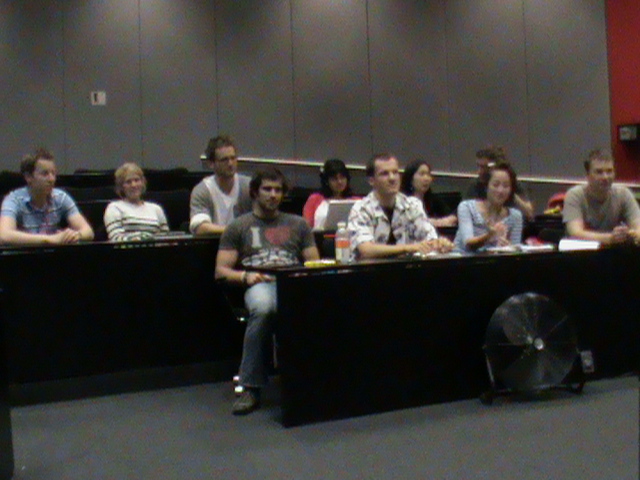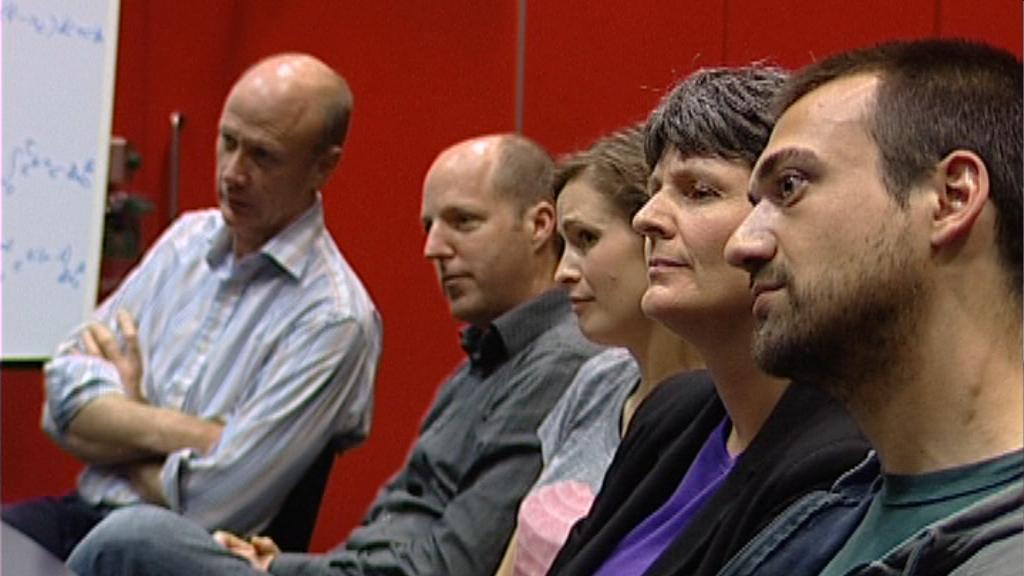Team:Imperial College London/Human Practices/Panel Discussion
From 2010.igem.org
| Human Practices | Overview | Panel | Workshop | Meetings | Report | Documentary |
| Human practices has been a hugely important influence in the design of our final product. We contacted a number of experts very early on in the design process to allow us to truly adapt our specifications to meet the requirements of a field testing kit for parasites. This has ensured that our design is as feasible and useful as possible. | |
| Interdisciplinary Human Practices Panel Discussion | |||
| As we refined our ideas for our own project we kept the issues in mind that we had discussed during our human practices workshop (see Workshop section on this page), and in week two, we presented our developing project to an interdisciplinary human practices panel for discussion.
This panel discussion was attended by a number of academics working in a variety of fields related to synthetic biology including the social sciences and design. At the time we felt that we would have liked to prepare more for the discussion, however in hindsight, it was really important that it took place so early on during the conception of our project. This is because the guidance of the panel had a significant impact on the specifications we chose for our project design. We are very thankful to the following academics for their invaluable advice:
We presented our project to the panel, highlighting the social, environmental, economic and political aspects of our project as we saw them. We then fielded questions from the panel, and finished with a discussion of the future direction for our project. Throughout this session, the panel encouraged us to think through both the human practices aspects and practical dimensions of our project, while also challenging us to question the assumptions we were unconsciously making about the populations affected by schistosoma.
Why would detecting Schistosoma be useful? In deprived rural communities, where resources are limited and healthcare provision is poor, a detection system for parasites could allow the treatment of water systems by using simple, harmless chemicals. It might also increase awareness of the presence of the parasite, and so people in the surrounding areas can be advised to let the water stand for 24 hours before use (in which time the cercariae will die) or to use an alternative source of water, if possible. Epidemiological studies of neglected tropical diseases (NTDs) are necessary to ascertain the efficacy of disease prevention and treatment. Disease mapping allows the analysis of, for example, the impact of climate change on vector-borne diseases through the use of virtual mapping applications such as Google Earth. The Infectious Disease Epidemiology Department at Imperial College London have established www.spatialepidemiology.net; one of several websites where geospatial health is being established as an essential factor in the study of disease. One advantage of disease mapping is that it allows more effective intervention at the local level. In addition to this, environmental components are considered in relation to morbidity, so that models can be built to offer more accurate predictions of how a disease can behave on a global scale. CONTRAST, a network of researchers across sub-Saharan Africa, carries out schistosomiasis risk mapping and prediction. Of particular interest is the transmission of the disease and host-parasite dynamics (Stothard et al, 2008).
The systems currently in use for detecting schistosoma in the field are often expensive, time-consuming and are relatively insensitive. They are therefore unsuitable for use in the field. Some examples include filtration and RT-PCR. It is much easier to detect the parasite after it has infected a human, by testing stool or urinary samples with microscopy or blood with an antibody test.
This is very unlikely, because the proteases are vital for the entry of the cercariae into the human body. If the specificity of these changed, they would not be able to invade the body and as a consequence, the cercariae would die within 24 hours.
While this would be an ideal solution, it represents a significant logistical problem, especially in rural settings. Among the 8 Millennium Development Goals (MDGs) for 2015 set out by WHO, basic sanitation features as a key factor in the fight to combat extreme poverty. The target is that by 2015, only 23% of the population will be living without improved sanitation. However, at the current rate of progress, the projected figure for 2015 is currently 36%, meaning that an extra 1 billion people who should benefit from the MDGs will miss out (WHO/UNICEF, 2010). This shortfall in the number of people who have access to improved sanitation is mostly due to poor infrastructure, lack of sustainability and ineffective financial aid. Therefore, we propose that a combination of approaches is needed to compliment the use of the detection kit. This could include enhanced sanitation and improved access to essential medicines and education where needed.
For synthetic biology to be of real use in this age, and in applications such as parasite detection, it is fundamental that we get a fast response. Nowadays people expect results quickly, and the wider public could easily not notice the potential that synthetic biology has if the results were not seen on a fast enough timescale. NTDs are most prevalent in remote settings, where resources are limited and vast areas of land are needed to be tested as quickly as possible. Therefore, a quick output would facilitate a greater frequency of testing. |
 "
"





